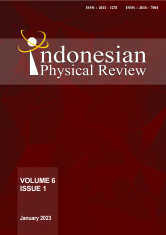DETERMINATION OF RUPTURE DIRECTIVITY USING THE LEVENBERG-MARQUARDT ALGORITHM: A CASE STUDY PHILIPPINE EARTHQUAKE (15 DECEMBER 2019 M_w 6.8)
DOI:
10.29303/ipr.v6i1.199Downloads
Abstract
Earthquake source mechanisms are used to determine local geological characteristics and hazard mitigation. There are several approaches to determine the mechanism of earthquake. In this paper, the relative time of the rupture duration is applied to determine rupture directivity. In determining rupture directivity, the Levenberg-Marquardt (LM) method is proposed to solve the inversion problem. To test the reliability of this method, teleseismic data with an epicentral distance of 40o from the Philippine earthquake on 15 December 2019  6.8, which had a good seismic station distribution with a total of 35 stations, is used. Telesismic data from each station is filtered in the range of 0.25 to 1 Hz to obtain an accurate rupture duration. Furthermore, the rupture duration data set was inverted using the LM method to obtain the direction of earthquake rupture. The results obtained by the curve fitting using the LM method had a good agreement between the observed data and the calculated data. From the curve fitting results, the rupture propagated in the NW direction with azimuth 320.60o ± 2.30o, and this had the same results from previous studies. Therefore, from rupture directivity, the actual fault plane of this earthquake was NP1 which had a strike/dip/rake value of 321o/75o/13o, respectively. The results indicate that the Philippines earthquake of 15 December 2019 had the SE-NW fault orientation, which is part of the Cotabato fault system. The implication of this research is for a preliminary study related to the characteristics of earthquake rupture in areas that have a high level of seismicity. Thus, local residents can avoid areas where ruptures propagate when carrying out earthquake mitigation.
Keywords:
actual fault plane Levenberg-Marquardt method Philippine earthquake rupture duration rupture directivityReferences
“The Philippine Institute of Volcanology and Seismology (PHIVOLCS),†Accessed on: Sep. 11, 2021. [Online]. Available: https://www.phivolcs.dost.gov.ph.
“The United States Geological Survey (USGS). Earthquake Hazards,†Accessed on: Sep. 11, 2021. [Online]. Available: https://earthquake.usgs.gov/earthquakes/
Y. Fukushima, M. Hashimoto, M. Miyazawa, N. Uchida, and T Taira, “Surface creep rate distribution along the Philippine fault, Leyte Island, and possible repeating of Mw ~ 6.5 earthquakes on an isolated locked patch,†Earth, Planets, and Space, vol. 71 no. 118, 2019. https://doi.org/10.1186/s40623-019-1096-5
B. Li, Y. Li, W. Jiang, Z. Su, and W. Shen, “Conjugate ruptures and seismotectonic implications of the 2019 Mindanao earthquake sequence inferred from Sentinel-1 InSAR data,†International Journal of Applied Earth Observation and Geoinformation, vol. 90 no. 102127, 2020. https://doi.org/10.1016/j.jag.2020.102127
Madlazim, T. Prastowo, and M. N. Fahmi, “Estimation of rupture directivity, CMT and earthquake tsunami parameters and their correlation with the main source of the first tsunami wave, September 28, 2018,†Science of Tsunami Hazards, vol. 39 no. 4, pp. 228–242, 2020. http://www.tsunamisociety.org/394MadlazimEtAl.pdf
S. Wang, X. Zeng, M. Xu, Y. Zhang, Y. Zhou, X. Wei, and X. Lin, “Rupture directivity of the 25 November 2018 Taiwan Strait Mw5.8 earthquake and its tectonic implications,†Tectonophysics, vol. 809 no. 228852, 2021. https://doi.org/10.1016/j.tecto.2021.228852
N. Haskell, “Total Energy and Energy Spectral Density of Elastic Wave Radiation from Propagating Faults.,†Bulletin of the Seismological Society of America, vol. 54 no. 6A, 1964. https://doi.org/10.1785/BSSA05406A1811
S. Stein and M. Wysession, An Introduction to Seismology, Earthquakes, and Earth Structure. Oxford: Blackwell Science. 2003.
A. Lomax and A. Michelini, “Tsunami early warning using earthquake rupture duration and P-wave dominant period: the importance of length and depth of faulting,†Geophysical Journal International, vol. 185 no. 1, pp. 283–291, 2011. https://doi.org/10.1111/j.1365-246X.2010.04916.x
Madlazim, “Assessment of tsunami generation potential through rapid analysis of seismic parameters,†Science of Tsunami Hazards, vol. 32 no. 1, pp. 29–38, 2013. http://www.tsunamisociety.org/321Madlazim.pdf
A. Lomax and A. Michelini, “Tsunami early warning using earthquake rupture duration,†Geophysical Research Letters, vol. 36 no. L09306, 2009. https://doi.org/10.1029/2009GL037223
López-Comino, F. de L. Mancilla, J. Morales, and D. Stich, “,Rupture directivity of the 2011, Mw 5.2 Lorca earthquake (Spain),†Geophysical Research Letters, vol. 28, no. 3, 2012. https://doi.org/https://doi.org/10.1029/2011GL050498
J. -Ã. López-Comino, D. Stich, J. Morales, and A. M. G. Ferreira, “Resolution of rupture directivity in weak events: 1-D versus 2-D source parameterizations for the 2011, Mw 4.6 and 5.2 Lorca earthquakes, Spain,†Journal of Geophysical Research: Solid Earth, vol. 121, no. 9, pp. 6608–6626, 2016. https://doi.org/https://doi.org/10.1002/2016JB013227
D. W. Marquardt, “An Algorithm for Least-Squares Estimation of Nonlinear Parameters,†J. Soc. Ind. Appl. Math. vol. 11, no. 2 pp. 431–441. 1963. https://doi.org/10.1137/0111030
K. Madsen, H. Nielsen, and O. Tingleff, Methods for Non-Linear Least Squares Problems (2nd ed.). 2004.
M Lourakis, A Brief Description of the Levenberg-Marquardt Algorithm Implemented by Levmar. 2005.
N. A. Haskell, “Total energy and energy spectral density of elastic wave radiation from propagating faults,†Bulletin of the Seismological Society of America, vol. 54, no 6A, pp. 1811–1841, 1964. https://doi.org/10.1785/BSSA05406A1811
R. D. Hwang et al., “Rise time and source duration of the 2008 MW 7.9 Wenchuan (China) earthquake as revealed by Rayleigh waves,†Earth, Planets, and Space, vol 63, no. 5, pp. 427–434, 2011. https://doi.org/10.5047/eps.2011.01.002
L. M. Warren and P. G. Silver, “Measurement of differential rupture durations as constraints on the source finiteness of deep-focus earthquakes,†Journal of Geophysical Research: Solid Earth, vol. 11, no. B6, 2006. https://doi.org/https://doi.org/10.1029/2005JB004001
“Global Centroid-Moment-Tensor (CMT),†Accessed on: Sep. 13, 2021. [Online]. Available: https://www.globalcmt.org/CMTsearch.html
“The United States Geological Survey (USGS),†Accessed on: Sep. 13, 2021. [Online]. Available: https://earthquake.usgs.gov/earthquakes/search
J. M. Hammarstrom, A. A. Bookstrom, M. W. Demarr, C. L. Dicken, S. Ludington, G. R. Robinso Jr, and M. L. Zientek, “Porphyry copper assessment of East and Southeast Asia: Philippines, Taiwan (Republic of China), Republic of Korea (South Korea), and Japan,†Scientific Investigations Report, no. 2010–5090, 2014. https://doi.org/10.3133/sir20105090P
L. Zhao, C. Qu, X. Shan, D. Zhang, W. Gong, and Y. Li, “Coseismic deformation and multi-fault slip model of the 2019 Mindanao earthquake sequence derived from Sentinel-1 and ALOS-2 data,†Tectonophysics, vol. 799, no. 228707, 2021. https://doi.org/https://doi.org/10.1016/j.tecto.2020.228707
License

This work is licensed under a Creative Commons Attribution-NonCommercial-ShareAlike 4.0 International License.
Authors who publish with Indonesian Physical Review Journal, agree to the following terms:
- Authors retain copyright and grant the journal right of first publication with the work simultaneously licensed under a Creative Commons Attribution-ShareAlike 4.0 International Licence (CC BY SA-4.0). This license allows authors to use all articles, data sets, graphics, and appendices in data mining applications, search engines, web sites, blogs, and other platforms by providing an appropriate reference. The journal allows the author(s) to hold the copyright without restrictions and will retain publishing rights without restrictions.
- Authors are able to enter into separate, additional contractual arrangements for the non-exclusive distribution of the journal's published version of the work (e.g., post it to an institutional repository or publish it in a book), with an acknowledgment of its initial publication in Indonesian Physical Review Journal.
- Authors are permitted and encouraged to post their work online (e.g., in institutional repositories or on their website) prior to and during the submission process, as it can lead to productive exchanges, as well as earlier and greater citation of published work (See The Effect of Open Access).





